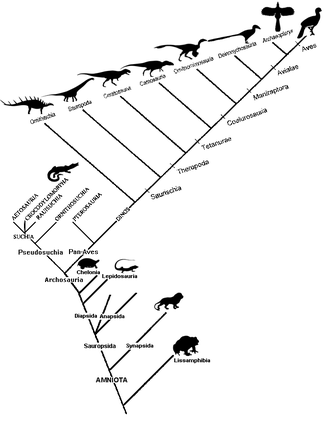Cladogram




Cladogram is a diagram used in cladistics which shows relations among organisms. A cladogram is not, however, an evolutionary tree because it does not show how ancestors are related to descendants or how much they have changed; rather, it shows the relative degrees of relatedness among lineages. The main purpose of a cladogram is to represent the hypothetical evolutionary relationships between different species or groups based on their shared derived characteristics, known as synapomorphies.
Construction[edit]
The construction of a cladogram is based on the principles of comparative anatomy, molecular biology, and genetics. It involves the identification of homologous characteristics among a set of organisms. These characteristics can be morphological (shape and structure), biochemical, genetic, or even behavioral traits that are shared due to common ancestry. The process begins with a list of organisms and their characteristics, which is then used to construct a matrix that codes for the presence or absence of these traits. Using algorithms and computational methods, the most parsimonious tree, which requires the least evolutionary changes, is selected as the most likely hypothesis of relationships.
Reading a Cladogram[edit]
A cladogram is read by looking at the points where branches intersect, which are called nodes. Each node represents a hypothetical common ancestor that gave rise to the groups stemming from it. The length of the branches can sometimes represent the number of changes that have occurred in the lineage, although this is not always the case. The tips of the branches represent the groups being compared, which can be living species, extinct species, or larger groups.
Importance[edit]
Cladograms are crucial in the field of systematics, the study of the diversity and relationships of organisms. They help scientists understand the evolutionary history of life on Earth by providing a framework for classifying organisms based on shared characteristics rather than physical similarities alone. This approach, known as phylogenetic systematics, has led to the reclassification of many organisms and a better understanding of evolutionary relationships.
Controversy[edit]
The interpretation of cladograms can be controversial, especially when the data are sparse or when different datasets (e.g., morphological vs. molecular) suggest different relationships. The choice of characteristics and the methods used to construct a cladogram can significantly affect the outcome, leading to debates within the scientific community about the best way to represent evolutionary relationships.
Conclusion[edit]
Cladograms are a fundamental tool in modern biology, providing insights into the evolutionary history and relationships among organisms. Despite their limitations and the potential for controversy, they continue to be a critical component of evolutionary biology, systematics, and taxonomy.

Ad. Transform your life with W8MD's Budget GLP-1 injections from $75


W8MD offers a medical weight loss program to lose weight in Philadelphia. Our physician-supervised medical weight loss provides:
- Weight loss injections in NYC (generic and brand names):
- Zepbound / Mounjaro, Wegovy / Ozempic, Saxenda
- Most insurances accepted or discounted self-pay rates. We will obtain insurance prior authorizations if needed.
- Generic GLP1 weight loss injections from $75 for the starting dose.
- Also offer prescription weight loss medications including Phentermine, Qsymia, Diethylpropion, Contrave etc.
NYC weight loss doctor appointmentsNYC weight loss doctor appointments
Start your NYC weight loss journey today at our NYC medical weight loss and Philadelphia medical weight loss clinics.
- Call 718-946-5500 to lose weight in NYC or for medical weight loss in Philadelphia 215-676-2334.
- Tags:NYC medical weight loss, Philadelphia lose weight Zepbound NYC, Budget GLP1 weight loss injections, Wegovy Philadelphia, Wegovy NYC, Philadelphia medical weight loss, Brookly weight loss and Wegovy NYC
|
WikiMD's Wellness Encyclopedia |
| Let Food Be Thy Medicine Medicine Thy Food - Hippocrates |
Medical Disclaimer: WikiMD is not a substitute for professional medical advice. The information on WikiMD is provided as an information resource only, may be incorrect, outdated or misleading, and is not to be used or relied on for any diagnostic or treatment purposes. Please consult your health care provider before making any healthcare decisions or for guidance about a specific medical condition. WikiMD expressly disclaims responsibility, and shall have no liability, for any damages, loss, injury, or liability whatsoever suffered as a result of your reliance on the information contained in this site. By visiting this site you agree to the foregoing terms and conditions, which may from time to time be changed or supplemented by WikiMD. If you do not agree to the foregoing terms and conditions, you should not enter or use this site. See full disclaimer.
Credits:Most images are courtesy of Wikimedia commons, and templates, categories Wikipedia, licensed under CC BY SA or similar.
Translate this page: - East Asian
中文,
日本,
한국어,
South Asian
हिन्दी,
தமிழ்,
తెలుగు,
Urdu,
ಕನ್ನಡ,
Southeast Asian
Indonesian,
Vietnamese,
Thai,
မြန်မာဘာသာ,
বাংলা
European
español,
Deutsch,
français,
Greek,
português do Brasil,
polski,
română,
русский,
Nederlands,
norsk,
svenska,
suomi,
Italian
Middle Eastern & African
عربى,
Turkish,
Persian,
Hebrew,
Afrikaans,
isiZulu,
Kiswahili,
Other
Bulgarian,
Hungarian,
Czech,
Swedish,
മലയാളം,
मराठी,
ਪੰਜਾਬੀ,
ગુજરાતી,
Portuguese,
Ukrainian